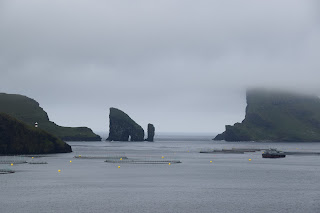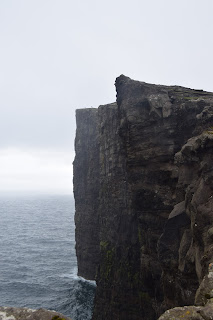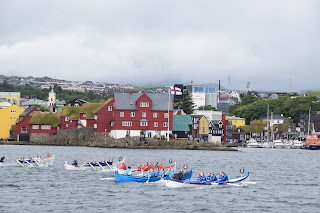Ever
since hearing the shipping forecast with ‘Faroes South Easterly force 7 increasing to 10’ there
has been an inclination to visit these far flung islands half way to Iceland.
We were fortunate to be joined by Michael (who had been picked as part of a
refereeing squad for an international touch rugby competition in Nottingham) and
Natalie (who was undestandaby keen not to be left behind). As a result we had a
beautiful new 4 bedroom unit where wooden finishes were the order of the day together
with a spectacular view over the capital Torshavn and nearby island Nolsoy.
The first couple of days were
glorious with blue sky and sea as well as green mountains dominating the greyer
town. However, weather changes were frequent and these colours quickly gave way to grey when 5 metre visibility fog descended.
Helen had undertaken some
planning and ensured our first trip was to a distillery so we could pick up
something for our evening aperitif. After our third sampling sitting was
appropriate.
One unusual aspect of this
distillery were the conference tables that had been imaginatively sculptured and
interwoven into a simple10 piece jigsaw.
We then moved down the road to a
museum. This was fascinating and covered a wide range of topics including the various
minerals that make up the basalt rock. One which I had not previously
encountered was Mesolitt. The crystals are so fine.
The Faroes comprises 18 islands
of which 16 are inhabited with a population of 54,000 (and half as many again
sheep!). Many of the islands are joined by (in some cases) long road tunnels
which although expensive has ensured connectivity. This in turn has made tourism
more attractive and stopped the exodus of younger people.
One claim to fame is the only
subsea roundabout in the world! (©Michael Halling photography – I was driving!)
A second ‘must’ was to see puffins. There was a small boat tour on offer which left from Vestmanna on the West coast of the main island. Hydro and fishing were clearly a foundation of this town.
There is a strong current
between the islands of Streymoy and Vagar which was ideal for testing a prototype
power generator. Although colourful we were reliably advised testing was not
going so well….
The puffin trip included a few
visits to some grottoes. This from my experience was quite a hairy experience as
the swell was high and entering, turning around and exiting did not include
much clearance to the adjoining 100-metre-high cliffs. I could have taken a
movie but the other team participants with lesser sea legs would not appreciate
the movement!
Sailing through this arch was a unique experience.
Although puffins were in abundance
and easily differentiated in flight given their frenetic flapping, the best close ups were when we were on firm
ground.
There were thousands of them –
on land
And at sea.
After
all that movement some down to earth shore entertainment was needed and we took
the short ferry ride to Nolsoy.
and walked to Maggies where
we enjoyed dinner with some jazz.
A
major reason to visit the Faroes was to undertake some walks. The first was a
short one to a waterfall on the NW of Vagar. Michael had brought along his
latest toy – a drone. It was an exciting trip as the wind was strong and its
small size ensured it was quickly out of sight. Nowadays that is not an issue
as the sophisticated software included a welcome return to base button.
Our first serious walk was to the lighthouse on Kalsoy. We left the village of Trollanes (population 10) and started a quite steep climb.
After a few muddy and slippery sections, we ended up at the
lighthouse and were rewarded with a wonderful rainbow springing from the
headland.
Walking slightly further along
the SW cliff edge we arrived at James Bond’s tombstone (No Time to Die). Michael
looks particularly pleased at visiting this given he has the whole suite of Bond movies…
The view back to the lighthouse helps with appreciating the height and sheerness of the cliffs.
We had travelled on the ferry
across to Kalsoy and taken a bus up the island. On the way back we had an hour
stop over at Mikladalur (population 50!). Here there is a statue of the Seal Woman.
The background really shows the ‘layered cake’ effect of the islands.
Fishing has long been the
main industry on the islands and now it includes farming. I wonder if the fish
farmers really appreciate their dramatic surroundings.
Our second hike was to ‘infinity lake’. The height of the cliffs was really mind blowing. This photo is some 50 metres above sea level. As you progress round the cliff it easily doubles that height. You can just see some hikers at the top. Coupled with wind gusts it really got the pulse racing!
The goal for the walk was at the end of the lake where it
seems to meld with the sea. A natural infinity pool.
In reality there is quite a
drop and substantial waterfall (which can just be differentiated from the large
breakers).
Just down the road from the unit
was a new church (2007). Its standout white shape made heading back to the unit
easy.
Although
the exterior was relatively bland the internal lighting, woodwork and windows
were particularly warm and appealing.
Over the years a major industry was whaling and we had the opportunity to visit a defunct station. It certainly was a brutal industry for all involved. From the initial spears, harpoon guns were developed that fired exploding audinence – a one shot kill.
Blubber
was boiled down into oil. There were huge boilers involved all nicely wrapped
in loose and fraying asbestos! In Australia the whole building would have been wrapped in plastic with no chance of visitors!
Whales were dragged up the
flensing station using winches. There is also one on the side so they could be
rolled over. Fortunately, the 80 year old industry ceased in 1985 and now whale
numbers are slowly on the increase.
A 10.8 km tunnel to the South
Island of Sandoy was recently completed (opened Dec 2023) and that enabled a
quick trip to ‘seal bay’. Although the drone was probably a new experience for
this large seal it did not seem to phase him one bit.
Our timing at the Faroes was
perfect as the last two days fell on the annual national holiday. Here most
locals went about in National costume and were happy to show off.
There was the expected parade and brass band.
But the main attraction was boat racing which carried on throughout the day. The locals clearly found this an exciting affair with many yelling on their teams. The entry gates in the afternoon had large queues and I suspect nearly all of the population was in attendance.
In the background to the above you can see the headland where the town was first established including many grass rooftops. They may appear quaint but living in these small buildings would have been a very cosy affair.
And the national holiday
concluded our week on the Faroes. Truly a hardy people with wind and overcast
skies the ‘norm’. We did wake up to zero visibility fog/rain on a couple of
days – and this was the height of summer! At least daylight hours were long. I
am not sure winter would have much appeal.



































